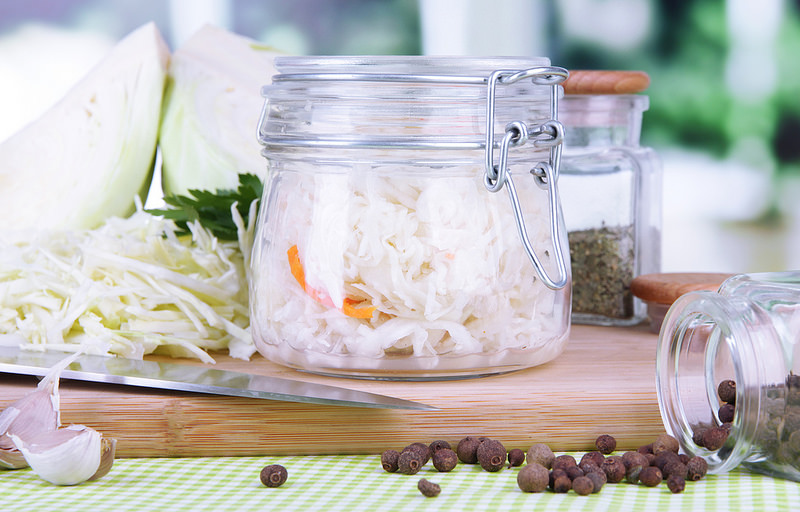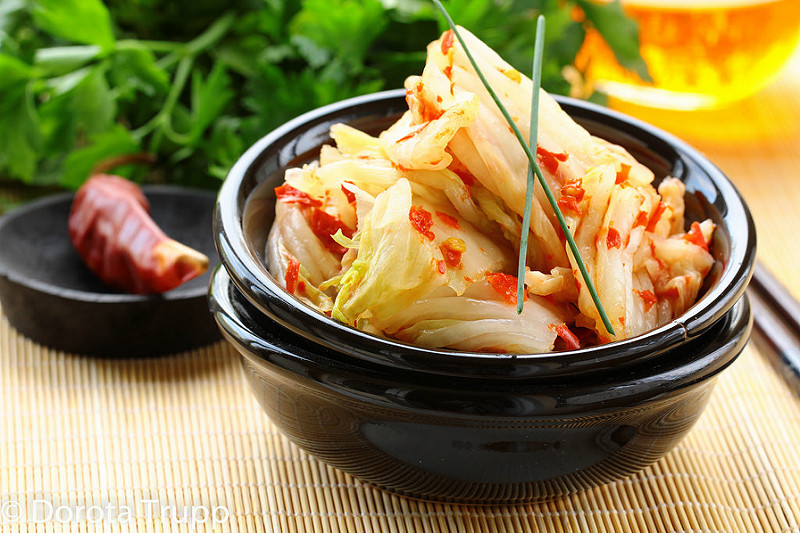Key Nutritional Facts about Probiotic Rich Fermented Foods & Kimchi Recipe
Probiotic Foods

Probiotic foods are fermented foods. They are rich in what are commonly called probiotic bacteria, which appear to have a very beneficial effect on our digestive tracts.
We each carry anywhere from 1.5– 3 litres of bacteria in our guts, which act as a protective barrier between the food we ingest and the intestinal wall. In fact, every centimetre of our intestines has a thick bacterial lining. The importance of this lining has been revealed by studies in which an animal’s gut has been sterilised (the bacteria destroyed), with fatal consequences.
According to Dr Natasha Campbell-McBride, who specialises in the nutritional treatment of disease, particularly in relation to the gut, our bacterial bands counter invasive, pathogenic microorganisms by producing antibiotic-like substances that have antifungal and antiviral characteristics. In addition, by producing organic acids, the beneficial bacteria reduce the alkalinity of the gut. This creates an uncomfortably acidic environment for the ‘bad’ microbes, which severely limits their growth and activity.
Our healthy indigenous bacteria also have the ability to neutralise many harmful chemicals and chelate heavy metals. The walls of their cells absorb many carcinogens, which are the basis of all cancer formation.
Probiotic foods have been consumed by humans for almost as long as we’ve existed. This is because fermentation is one of the simplest ways of preserving food. But with the invention of the icebox and the fridge, the need for fermentation tailed off. This is unfortunate, because when we look at the composition of the beneficial bacteria that we carry in our guts, we discover that it matches the composition of many strains of fermented foods. In other words, fermented foods supply us with a key element of our health.
This is very important considering how easily our gut bacteria can be depleted. Antibiotics, stress, too much sugar, environmental toxins and a diet high in processed foods all have a negative impact on the beneficial bacteria in our guts, essentially killing them off. When this happens – let’s say because of a course of antibiotics – then there is an opportunity for pathogenic flora to develop and take charge in our digestive tracts; this is what happens, for example, in people who experience candida overgrowth. If the health-protecting gut flora isn’t quickly re-established, any number of digestive problems will arise, as well as nutritional deficiencies, food intolerances and even immune system disorders. This is where probiotics-rich fermented foods come in, helping to restore the bacterial balance in the gut.
Fermented foods that you may wish to add to your diet include; yogurt, kefir, kambucha tea, sauerkraut, kimchi, tempeh, fermented ginger and apple cider vinegar.
When you purchase fermented food, remember to check the label to make sure it hasn’t been pasteurised – only buy unpasteurised products.
Below is a recipe for Kimchi
Kimchi Recipe
Kimchi is a traditional Korean dish of spicy fermented cabbage. Kimchi can be served as a side dish with many meals, it can also be eaten alone as a snack, or added to soups. Kimchi is one of the best probiotic foods you can add to your diet.

Kimchi pickling
First, the cabbage needs to be soaked and salted. Second, the marinade has to be prepared. Lastly, the cabbage is combined with the marinade and left to ferment for three weeks.
Preparing the cabbage
2 heads Chinese cabbage
2 cups sea salt
8 cups water
Trim the cabbage by removing any brown leaves on the outer layers. Slice the centre of the cabbage’s stem 5 centimetres deep. Using your thumbs and fingers, pull the cabbage into two sections on either side of the slit. Repeat for the remaining cabbage.
Soak the cabbage sections in salted water (8 cups water to 1 cup sea salt) for 20 minutes.
Remove the cabbage from the salt water and sprinkle the remaining 1 cup of salt between each of the cabbage leaves.
Return the cabbage to the salted water with the cut side facing up. Rotate the cabbage every two hours, bringing the cabbage on the bottom of the container to the top and vice versa.
After 5–6 hours, the texture of the cabbage will be rubbery. Wash the cabbage thoroughly and gently. Drain the cabbage in a colander, squeezing as much water from the leaves as possible. Set aside.
Preparing the marinade
1 cup sweet rice powder
5 cups water
140 grams garlic
280 grams Asian pear, peeled and quartered
250 grams onions, peeled and quartered
30 grams ginger, peeled
110 grams Fresno chillies
900 grams radish, julienned
110 grams minari
110 grams red mustard greens
110 grams Korean chives
110 grams spring onions
¾ cup Korean salted shrimp sauce
110 grams fresh shrimp, chopped
110 grams Korean salted shrimp
Combine the water with the sweet rice powder and whisk until smooth. Heat the water and rice powder mixture on the stove on medium–high heat, stirring occasionally to prevent it from sticking to the bottom of the pan. When bubbles start to form, reduce the heat and continue to stir. Once the mixture thickens and becomes translucent (approximately 10 minutes), take it off the heat.
Cool the mixture completely, then transfer it to a large bowl.
Place the onions, pear, garlic, ginger and Fresno chillies in a food processor and pulse until finely minced. Set aside.
Add the pureed chilli mixture along with the radish, minari, red mustard greens, chives and spring onions to the rice powder mixture. Combine the mixture thoroughly, making sure that the greens are completely incorporated.
Lastly, add in the anchovy fish sauce, salted shrimp sauce, and fresh and salted shrimp. Once again, combine the mixture very well. If mixing with your hands, be sure to wear rubber gloves to avoid chilli burn.
Preparing the kimchi
Take each cabbage and stuff the marinade mixture between the leaves, working from the outside in, and from the largest leaf to the smallest. Do not overstuff, but make sure the marinade mixture adequately fills the leaves.
When each cabbage is stuffed, take one of the larger leaves and wrap it tightly around the rest of the cabbage. Divide the cabbage among jars, pressing down firmly to remove any air bubbles. Each jar should only be 80% full because the kimchi will expand as it ferments. Keep the jars tightly sealed and refrigerated for at least 20 days.
Join us at Trupp Cooking School in our “The lost art of fermentation” cooking class for hands on experience learning to prepare fermented foods. Click here to view upcoming class dates and times.

